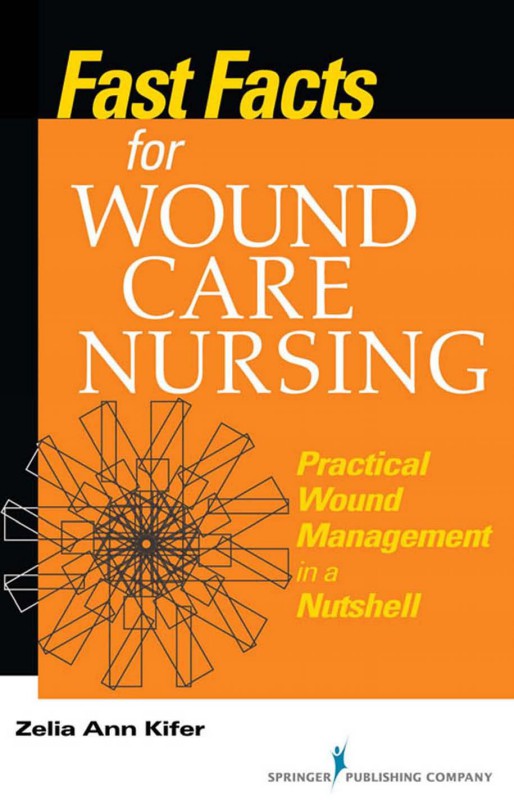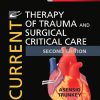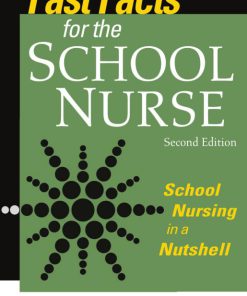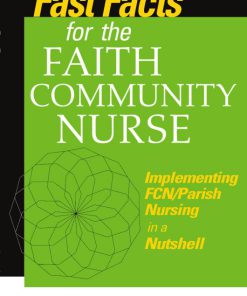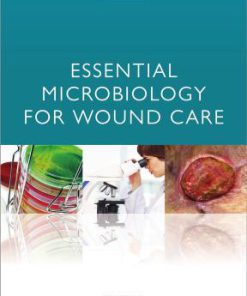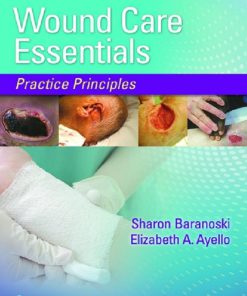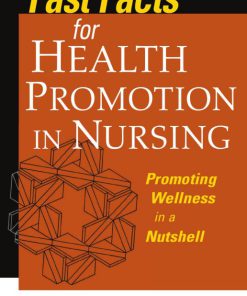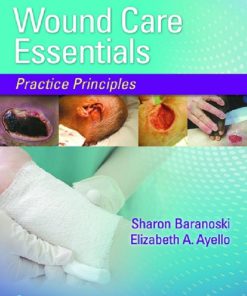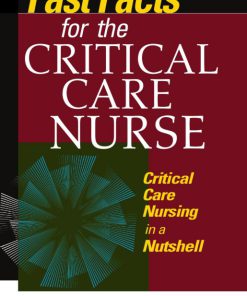FAST FACTS FOR WOUND CARE NURSING Practical Wound Management in a Nutshell 1st Edition by Zelia Kifer ISBN 9780826107763 0826107761
$50.00 Original price was: $50.00.$25.00Current price is: $25.00.
Authors:Zelia Ann Kifer; RN; BSN; CWS , Author sort:Kifer, Zelia Ann & RN & BSN & CWS , Published:Published:Oct 2011
FAST FACTS FOR WOUND CARE NURSING Practical Wound Management in a Nutshell 1st Edition by Zelia Kifer – Ebook PDF Instant Download/Delivery. 9780826107763 ,0826107761
Full download FAST FACTS FOR WOUND CARE NURSING Practical Wound Management in a Nutshell 1st Edition after payment

Product details:
ISBN 10: 0826107761
ISBN 13: 9780826107763
Author: Zelia Kifer
“This book is a user-friendly, real-world guide to assessing and managing any type of wound. The author presents vital information for nurses and nursing students who provide wound care in any setting…a wonderful resource for nurses.”–The AORN Journal (Association of Perioperative Registered Nurses)
“Wound care is arguably the single most difficult topic in medicine. It has no defined solution like insulin for the diabetic…no easy strategy that covers all wounds…we are so tremendously blessed when [a wound care specialist] like Zelia carves out time to capture a career of experiences in text so that it can be shared with others. We are indebted to her for making this important contribution to the clinician’s armament for dealing with [the] difficult-to-heal wounds of their patients.”
Bruce Gibbins, PhD
Founder, Chief Technical Officer and Chairman of the Board of AcryMed, Inc.
Former faculty at the University of Otago Medical School
Using the concise, compact Fast Facts format, this guide encompasses the multitude of new healing technologies and presents important breakthroughs in understanding why some wounds don’t heal. Each chapter builds, step-by-step, on the essential principles of wound care including wound assessment and documentation, the spectrum of wounds from simple to complex, wound treatment guidelines and protocols, and the legal aspects and regulations surrounding wound care. This user-friendly guide organizes the vast amount of information relating to wound care products and eases the complexity of wound management.
A “Fast Facts in a Nutshell” section in each chapter provides quick access to important wound care principles, and bullet-point information and tables enable readers to quickly locate relevant information. This guide will be a useful companion in the day-to-day care of wound patients, reinforcing knowledge needed in all practice settings, including acute care, critical care, long-term care, home care, operating room, and outpatient settings.
Key Features:
- Organizes and simplifies a vast amount of wound care information into a compact, user-friendly format
- Addresses wound care assessment, protocol, and treatment of the spectrum of wounds from simple to complex for all levels of practitioners
- Encompasses new healing technologies and information regarding difficult-to-heal wounds
- Presents comprehensive wound care algorithms, dressings, debridement procedures, ostomy care, optimal surface and equipment for wound patients, and adjunctive therapies
FAST FACTS FOR WOUND CARE NURSING Practical Wound Management in a Nutshell 1st Edition Table of contents:
Section I—Assessment, Measurement,and Documentation
1. Attacking the Basics: Know what Fuels a Wound and Understand the Outcome Goal
INTRODUCTION
THE PATIENT: THE PHYSIOLOGIC ENVIRONMENT COMPONENT
Malnutrition
Starvation
Body Mass Index (BMI)
Protein Requirements
Dehydration
Comparing the Needs of Burn Patients
The Harris-Benedict Equation
Indirect Calorimetry
THE WOUND CARE NURSE COMPONENT
Clinical Expert
EDUCATOR
RESEARCHER
THE DRESSING MANUFACTURE COMPONENT
2. Understanding Wound Etiology
INTRODUCTION
THE DIFFERENCES BETWEEN CHRONIC AND ACUTE WOUNDS
Description of Chronic Wounds
Description of Acute Wounds
THE THREE PHASES OF CHRONIC WOUND HEALING
Inflammatory Phase
Proliferation Phase
Remodeling Phase
TYPES OF WOUND CLOSURE
Primary Intention
Secondary Intention
Tertiary (Delayed Primary) Intention
TYPES OF SCAR TISSUE
Hypertrophic Scars
Keloid Scars
Contractures
INFECTIONS AND BIOBURDENS
Bioburdens
Biofilms
Treatment of Biofilms
WOUND ODORS
Professional Behavior for Managing Wound Odors
Identify and Understand Odor Sources
Recommendations for Effective Wound Odor Control
Recommendations for Effective End-Stage Draining Wound Odor Control
3. Assessing and Documenting Wound
INTRODUCTION
RECOGNIZING AND MANAGING PAIN
Basics of Pain Assessment
Pain Scales
Pain Management: Be Confident With Providing Analgesia
OBTAINING A PATIENT’S HISTORY
DOCUMENTING A WOUND
DOCUMENTATION OF ASSESSMENT FINDINGS
4. Debriding Wounds
INTRODUCTION
INDICATIONS FOR DEBRIDEMENT
Gangrene
Signs and Symptoms of Gangrene
Treatment for Gangrene
TYPES OF DEBRIDEMENT
The Four Kinds of Sharp Debridement
Advantages of Sharp Debridement
Disadvantages of Sharp Debridement
Autolytic Debridement
Advantages of Autolytic Debridement
Disadvantages of Autolytic Debridement
Enzymatic Debridement
Advantages of Enzymatic Debridement
Disadvantages of Enzymatic Debridement
Biodebridement
Advantages of Biodebridement
Disadvantages of Biodebridement
Chemical Debridement
Advantages of Chemical Debridement
Disadvantages of Chemical Debridement
Mechanical Debridement
Irrigation
Hydrotherapy
5. Documenting and Photographing Wound
INTRODUCTION
THE KEY TO GOOD DOCUMENTATION: BE THOROUGH AND CLEAR
Documentation Guidelines
The National Level
The Local Level
PHOTOGRAPHIC DOCUMENTATION
Key Elements of Photograpic Documentation
Section II—Defining the Spectrum of Simple to Complex Wounds
6. Skin Injuries
INTRODUCTION
SUPERFICIAL SKIN INJURIES
Abrasions, Scrapes, and Tape Burns
Treatment
Bruises
Treatment
Superficial Burns
Treatment
Superficial Cuts and Scratches
Treatment
DEEP TISSUE INJURIES AND PRESSURE ULCERS
Deep Tissue Injury (DTI)
Stage I Pressure Ulcer
Care and Prevention
SKIN TEARS
The Payne−Martin Classification System for Skin Tears
Treatment Options for Skin Tears
Care and Prevention of Skin Tears
7. Common Chronic Wounds
INTRODUCTION
CHRONIC WOUNDS
VENOUS INSUFFICIENCY ULCERS
Characteristics of Venous Ulcers
Pathophysiology of Venus Insufficiency Ulcers
Indications for Testing Procedures
Testing Procedures
Treatment and Therapy Priorities
Prevention Stage
Management Stage
Treatment Stage
Types of Compression Therapy
LYMPHEDEMA FLUID LEAKING
The Common Stages of Lymphedema
Severity Grades for Lymphodema (Referenced to a Healthy Extremity)
Treatment and Therapy Priorities
Four- Layer Compression System Instructions
ARTERIAL ULCERS
Indications for Testing Procedures of Ischemic Pain
Testing Procedures for Arterial Ulcers
Guidelines for Obtaining an ABI (Known as the Sixth Vital Sign)
Interpretation of an ABI
Treatment and Therapy Priorities for Arterial Ulcers
Prevention Stage
Management Stage
Treatment Stage
PRESSURE ULCERS
Pressure Ulcers Defined
Used with permission from the NPUAP. Predicting Pressure Ulcer Risk
Taking the Confusion Out of Reverse Staging
Treatment and Therapy Priorities
DIABETIC ULCERS
Diabetic Neuropathy Origins
Hyperglycemia Slows Wound Healing
Types of Neuropathy
Routine Assessment
Wagner Classification of Diabetic Foot Ulcers
Treatment and Therapy Priorities for Diabetic Wounds
8. Complex Wounds
INTRODUCTION
INITIAL SIGNS AND COMPLICATIONS OF COMPLEX WOUNDS
BURNS
Determining the Severity of a Burn
Depth of a Burn
Extent of a Burn
Type of Burn
Referral Criteria
SKIN GRAFTS AND TISSUE FLAPS
Managing Wounds When a Patient Is Not a Candidate for Graphs or Flaps
9. Recognizing Atypical Wounds
INTRODUCTION
TYPES OF ATYPICAL WOUNDS ANDTHEIR ETIOLOGIES
Vasculitis Disorders
Identifying Skin Features
Wound Care Treatment
Calciphylaxis
Identifying Skin Features
Wound Care Treatment
Pyoderma Gangrenosum
Identifying Skin Features
Wound Care Treatment
Brown Recluse and Black Widow Spider Bites
Identifying Skin Features
Wound Care Treatment
Viral Infections That Cause Atypical Wounds
Herpes Simplex (HSV)
Two Phases of Infection
Treatment
Varicella- Zoster Virus (VZV)
Treatment
Symptoms
Treatment
Section III—Wound Care Treatment and Protocols
10. Understanding Wound Care Guidelinesand Protocols
INTRODUCTION
Exhibit 10.1 Policy/Procedure Template
Exhibit 10.2 Treatment Option Guidelines Based on Best Practice
11. Selecting the Correct Dressings for Optimal Wound Care
INTRODUCTION
WOUND CARE PRODUCTS AND CROSS-REFERENCED DIRECTORIES
Exhibit 11.1 Skin and Wound Care Guidelines
12. Using Adjunctive Therapies
INTRODUCTION
ADJUNCTIVE THERAPIES AND DIRECTORIES
Exhibit 12.1 Electrical Stimulation
Exhibit 12.2 Hyperbaric Oxygenation
Exhibit 12.3 Lymphatic Drainage Therapy
Exhibit 12.4 Negative- Pressure Wound Therapy
Exhibit 12.5 Pulsatile Lavage With Suction
13. Caring for Ostomies and Fistulas
INTRODUCTION
OSTOMIES
Stoma Assessment
Stoma Measurement
Common Stoma Complications
The Pouching System
Ostomy and Fistula Products, Actions, and Indications
Ostomy Supplies and Medicare Limits
FISTULAS
Assessing Fistulas
Location
Drainage (Figure 13.1)
Goal for a Plan of Management
Investigate the Cause
Perifistular Skin
Mortality Rates
Nutritional Management and Support
Odor Assessment
Nursing and Patient Support
Nurse to Patient
Nurse to Nurse
14. The Promotion of Skin Care Integrity
INTRODUCTION
FACTORS THAT AFFECT SKIN INTEGRITY
SKIN ASSESSMENT
Skin Assessment Indicators
Common Skin Care Formulary Options
Cleansers
Topical Antifungals
Moisturizers
FECAL AND BLADDER INCONTINENCE
Types of Incontinence Products
15. Selecting Optimal Support Surfaces and Equipment for Patient Positioning
INTRODUCTION
SUPPORT SURFACES
Factors Guiding Selection of a Support Surface
Bariatric Equipment Reality Check
Exhibit 15.1 CMS Support Surface Guidelines
Exhibit 15.2 Sample Bed Tracking Form
Section IV—Legal Aspects and Regulations
16. Qualifications and Certifications for Specializing in Wound Care
INTRODUCTION
WOUND CERTIFICATION PROGRAMS
The Wound, Ostomy, and Continence Nursing Certification Board (WOCNCB)
The American Academy of Wound Management (AAWM)
The Wound Care Education Institute (WECI)
The National Alliance of Wound Care (NAWC)
Wound Care Organizations and Associations
17. Awareness of Your Facility’s Reputation: Certification and Accreditation
THE JOINT COMMISSION (JC)
THE ANCC MAGNET RECOGNITION PROGRAM
Outside the Hospital Arena
AMERICAN MEDICAL DIRECTORS ASSOCIATION (AMDA)
The AMDA’s Priority Areas and Overall Goals
THE OUTCOME AND ASSESSMENT INFORMATION SET (OASIS)
Importance of Understanding the Accreditationand Certification Process
18. The Centers for Medicare and Medicaid Healthcare’s Common Procedure Coding System: Guidelines
INTRODUCTION
THE TWO HCPCS LEVELS
Level I
Level II
Understanding Reimbursement Guidelines
LEVEL II HCPCS CODES FOR WOUND CARE PRODUCTS
Making Cost- Effective Decisions Regarding Wound Care
Appendix: Description of Skin Lesions
Glossary
References and Additional Readings
Index
People also search for FAST FACTS FOR WOUND CARE NURSING Practical Wound Management in a Nutshell 1st Edition:
is wound care nursing stressful
how to specialize in wound care nursing
how to be a good wound care nurse
what to eat for wound recovery
You may also like…
eBook PDF
Fast Facts for the Faith Community Nurse 1st Edition by Janet Hickman ISBN 9780826107138 0826107133

